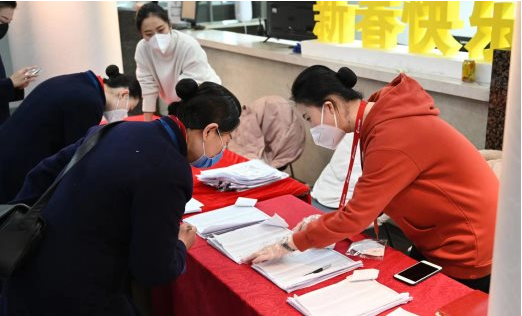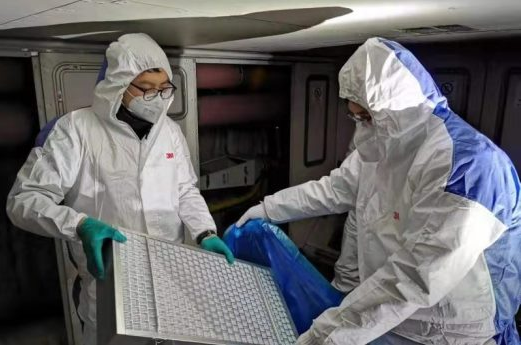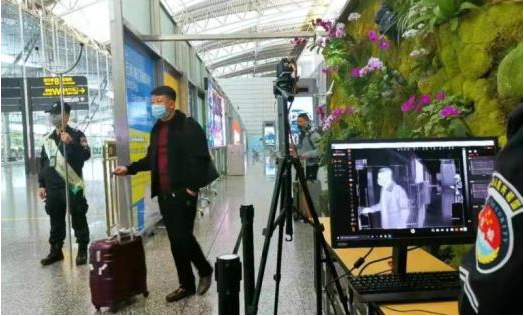The civil aviation industry welcomes the peak of return trips after the Spring Festival holidays. Facing the severe situation of epidemic prevention and control, the issue that concerns air travelers most is the protective measures of airlines and airports. In order to reassure the passengers and to ensure that every journey is safe, airlines and airports have tried to find ways to build “sturdy walls” to prevent the spread of disease. The following measures taken by staff in the front line, with a rational and accountable manner, have eased the minds of passengers.
Air China Aircraft Equipped with Medical Protective Equipment

Air China cabin crews fetching masks and having their temperatures taken and registered before working. Photo by Leng Bingjie
Recently, confronted with the COVID-19, Air China has made special planning and taken prompt actions to combat the disease and provide a safe cabin environment for passengers.
The flight and cabin crews make preparations before taking-off according to procedures, and have their temperatures taken and registered before departure. Air China provides its staff with medical equipment on every flight, including disposable latex gloves, disposable medical masks, quick-drying and rinse-free hand sanitizer and infrared thermometers.
In addition to emergency medical equipment such as precaution kit, Air China also prepares non-contact thermometers. Meanwhile, Air China strengthens training for cabin crew: adjust the content of in-flight passenger announcements to make explanations and suggestions for passengers, and further enhance health monitoring of passengers to ensure that cabin crew can properly manage passengers with fever in accordance with procedures while protecting themselves.
Air China increases the frequency of fleet disinfection, both for prevention and emergency response, in the cabin and in the cockpit, to fully guard against the virus. In the post-flight cleaning of each aircraft, Air China preventively disinfect every corner on board where passengers and crew members could touch, including cockpit, tray tables, seat armrests, window shades, luggage compartments and lavatories. For aircraft that have transported passengers with fever or charter flights that carried out emergency task to Wuhan, upon receiving the notice, the epidemic prevention personnel of Air China will disinfect the cabin as soon as possible when flights return.
Air China also adjusts plans for in-flight catering and supplies, maximizing the use of disposable tableware and enhancing the cleaning and effective disinfection of non-disposable tableware, to further improve the prevention and control of COVID-19 and reduce its spread.
It is reported that on February 3, China National Aviation Holding Corporation Limited, the dominant stockholder of Air China, donated 10 million yuan to Wuhan for epidemic prevention and control by the special account of State-owned Assets Supervision and Administration Commission of the State Council.
China Eastern Airlines: Passengers Could Fill out the Health Declaration Form Online
To prevent and control COVID-19, and to ensure the health of passengers, China Eastern Airlines has taken multiple measures to build a framework of epidemic prevention and control. On February 1, the Airlines promptly introduced an online channel for passengers to fill out the Heath Declaration Form.
Passengers traveled by China Eastern Airlines can fill out their Heath Declaration Forms online by logging in the WeChat account, APP or the mini program of China Eastern Airlines. When filling out the form, passengers are also required to provide their names, ID numbers used in ticket purchase and ways of contact. This online reporting not only helps to organize passengers’ information in advance, but also ensures that if confirmed cases are found, both the passenger and his close contact can be tracked, and the information of disease can thus be spread in time. For a few passengers that are not familiar with the use of mobile terminals, China Eastern Airlines will provide them with paper forms. Meanwhile, the mobile terminals of China Eastern Airlines also have the function of checking infected or suspected cases in fellow passengers.
China Eastern Airlines improves its epidemic prevention measures in a continuous manner during the return trip period of Spring Festival. In addition to the online reporting, it focuses on the disinfection of flights, counters, lounges and working areas. All crew members must wear protective equipment before working and must complete physical examination before the operation of flights. Various departments of the Airlines are now purchasing and collecting disinfection and protection equipment to intensify disease prevention. The Youth League Committees of its Flight Department and Technology Company also mobilize volunteers to work at the packaging station in mask factory to help producing masks, and therefore more masks can be provided to front line staff.
China Southern Airlines Ensures Fresh and Clean Air in the Cabin

Maintenance personnel of China Southern Airlines put the replaced air filter into a protective plastic bag. Photo by Chen Guangda
Recently, in order to prevent the spread of COVID-19 by aircraft, China Southern Airlines has adopted many measures to strengthen disease prevention both for its crew members and passengers.
Before boarding, personnel from ground service departments carry out strict control to prevent passengers who are confirmed or suspected cases of COVID-19 from boarding. During flight operation, China Southern Airlines follows the requirements of CAAC and adjusts in-flight catering standards, avoids repetitive use of blankets and earphones, replaces towels with wet wipes, and ceases the offering of meal and beverage menu to minimize contact between cabin crews and passengers. In the cabin, if chief attendant finds passengers with fever, he/she will immediately initiate emergency measures on board and report in time to inform the destination airport to prepare necessary epidemic prevention measures. After the flight, maintenance personnel will thoroughly disinfect the aircraft, change the fan filter of air conditioning circulation system, and put on a new "mask". The cabin air circulation systems on all aircraft are installed with high-efficiency particulate air filters and are changed regularly, which can ensure fresh and clean air in circulation systems.
On February 1, China Southern Airlines donated 10 million yuan to Hubei province by the special account of State-owned Assets Supervision and Administration Commission of the State Council.
Beijing Capital Airport Sets up Exclusive Route to Transfer Passengers with Fever
Recently, during the peak of return trips, Capital Airport carries out epidemic prevention and control in its nearby area, and fully implements various related measures to ensure the smooth and effective operation of flights that transport disease protective materials and passengers.
In terms of passenger protection, the airport increases fresh air supply in its terminals and ensure good ventilation, and strengthens monitoring in crowded areas in three terminals to acquire real-time information of passenger flow. It also increases the frequency of disinfection in three terminals. For relatively closed spaces, personnel are specially assigned to do the disinfection, which records are kept. According to preliminary statistics, about 740 persons carry out disinfection every day. The airport is also equipped with 49 temperature measuring devices to take the temperatures of all arriving passengers and all persons who get in and out of the terminals. For passengers with fever, special transfer procedures and routes are established for them to avoid contact with other passengers. The boarding bridges and baggage turntables used by flights which have transported passengers with fever will be disinfected immediately after flights.
In terms of ground transportation, the airport has suspended 8 inter-province shuttle buses in both directions since January 25, whereas all shuttle buses in Beijing and the Capital Airport Express have been operating normally. In accordance with the requirements of relevant authorities in Beijing, each security checkpoint of Capital Airport Express is now required to take passengers’ temperatures, and the ventilation and disinfection of both the shuttle buses and Capital Airport Express are now stepped up. Since it is the peak of return trips, Capital Airport opens alternative payments in its parking lots, such as Alipay, We-chat pay, unconscious payment, and Union Pay quick pass, so as to facilitate the rapid travel of passengers.
In addition, the airport is making full use of the display screens in three terminals, the large screen on the arrival floor in Terminal 3, the television and vertical digital screens at 352 gates to play the video of COVID-19 prevention and the latest news on the disease. While providing services for passengers, the airport also coordinates protective equipment with multiple parties to protect each personnel in the front line of epidemic prevention and control.
Local Disease Control Experts Providing Assistance at Two Airports in Shanghai

Shanghai airport staff guiding passengers to take temperatures.
To strengthen the epidemic prevention, Shanghai Pudong Airport and Hongqiao Airport have begun to require arriving passengers from China to fill out the Health Declaration Form online from February 2, and passengers can scan QR codes to submit their forms. Prior to the online reporting, the two airports had taken temperatures for all arriving passengers and all persons that get in and out of the terminals.
Meanwhile, Shanghai Pudong Airport has established a joint emergency mechanism with Shanghai Pudong New District, and Shanghai Hongqiao Airport with Changning District and Minhang District. According to the mechanism, three districts have sent disease control experts to give guidance to the two airports, and assigned professional staff to work at medical observation points in the terminals of two airports.
In order to help passengers to get health information to protect themselves and fill out the forms in time, more than a thousand publicity booths have been set up at two airports. If passengers with abnormal temperatures and who comply with relevant inspection regulations are found after completing the forms and having temperatures taken, the airport will notify the ambulance and send them to designated medical institutions nearby for treatment; if passengers from distressed epidemic areas do not have fevers and comply with the isolation requirements, the airport will send them to centralized isolation places for medical observation in a timely manner.
The two airports now strengthen the ventilation and disinfection of crowded areas such as terminals, increase the supply of fresh air in public places, preventively disinfect service facilities as well as air-conditioning filters and screens, and provide front line staff with protective equipment, including masks.
The two airports in Shanghai have begun to take and register arriving passengers’ temperatures from Wuhan since January 22. This measure then rapidly expanded to all arriving passengers from Hubei province, and then to all arriving passengers, and finally to all passengers on flights coming in and out of Shanghai and all people who enter public places such as terminals and office buildings.
Shanghai Pudong Airport is the largest air cargo hub in China and an important air gateway for the transportation of epidemic prevention materials from all over the world. Pudong Airport Cargo Station opened a green channel at earliest time possible, and cooperated with airport customs, import enterprises and various airlines to establish a channel for sharing information on cargo notification and delivery, and therefore achieve immediate inspection and fast customs clearance of emergency materials. Since January 22, more than 40 batches, 2,034 pieces and a total of 69 tons of epidemic prevention and control materials have been efficiently processed through the green channel of Pudong Airport cargo terminal.
Full Temperature Monitoring in Guangzhou Baiyun Airport

Guangzhou Baiyun Airport conducts full temperature monitoring. Photo by Bai Yunxuan.
Taking into consideration the features of return trips after the Spring Festival, Guangzhou Baiyun Airport now fully strengthens airport disinfection, and carries out temperature monitoring of arriving passengers and persons entering the terminals.
Baiyun Airport now implements a 24-hour shift and establishes a longstanding contact mechanism with local health commission, disease control and prevention department, and field entities at the airport. Based on the actual situation, the airport quickly develops and launches a working plan for epidemic prevention and control as well as a special emergency plan, which mainly consists of four prevention and control measures.
The airport works with local health and quarantine department and public security department to monitor the temperature of arriving passengers and persons entering the terminals. Meanwhile business owners and managers in the public places within the airport’s jurisdiction are required to put up distinct and clear notices at the entrance, reminding travelers to wear masks, for which the inspections are stepped up as well. The airport strictly implements four "fixed" measures for flights returning from the epidemic areas: fixed aircraft bridges, fixed supporting vehicles, fixed temperature checkpoints, and fixed working processes. Also, ventilation in public places of the airport is intensified; special tasks are assigned to protect the safety of crowded places, including terminal and public areas; the prices of protective materials being sold at the terminals are also closely monitored to crack down price gouging. The airport strictly implements measures such as employee protection and home quarantine, which require all staff who have contact with passengers, and all personnel in public places and salesmen in shops to wear masks. Individuals coming from epidemic areas, and individuals returning or coming to Guangdong who have been to distressed epidemic areas must quarantine themselves at home as required and must be registered.
Baiyun Airport now has 67 fixed temperature checkpoints at two terminals and the integrated transportation centers, and 500 hand-held thermometers are equipped in such areas as parking lots and transit areas to monitor temperature manually.
Baiyun Airport sets up a joint working group with the health and quarantine department and the public security department, and develops a rapid response system for passengers with fever. The working group adopts a working mechanism that combines fixed temperature checkpoints and mobile inspections. Once people with fever are detected, the group will make immediate response and perform preliminary diagnosis as soon as possible, and carry out relevant measures in accordance with the guidelines issued by Guangzhou Center for Disease Control and Prevention.

